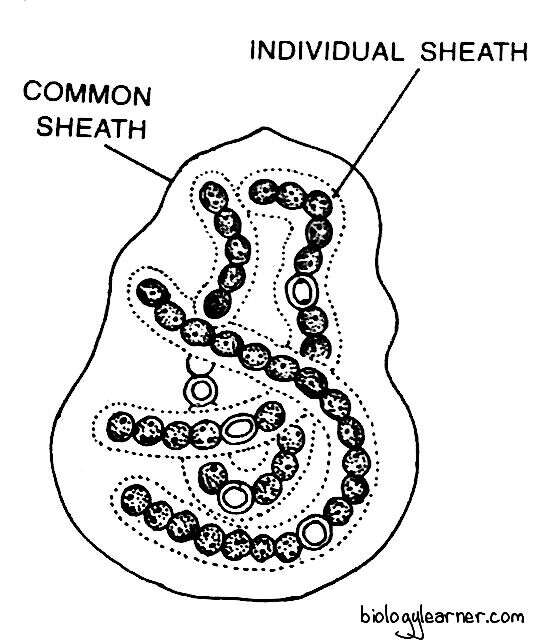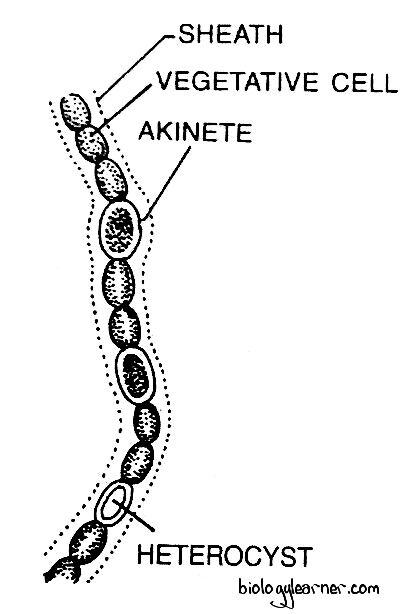Nostoc is the most common genus of Cyanobacteria (blue-green algae). It is found in both terrestrial and aquatic habitats.
Nostoc is also known as star jelly or spit of the moon due to its colonies, composed of filaments of moniliform cells in a gelatinous sheath of polysaccharides.
According to Desikachary (1959);
| Class: | Cyanophyceae |
| Order: | Nostocales |
| Family: | Nostocaceae |
| Genus: | Nostoc |
Salient Features of Nostoc
The salient features of Nostoc are as follows:
- The plant body is of the unbranched filamentous type, and many filaments are aggregated together within a gelatinous mass to form a colony.
- The colonies are greenish to bluish-green in color and contain many contorted or twisted trichomes.
- The trichomes are composed of rounded or oval cells. The cells are arranged in a single row, like beads on a string.
- Cells contain various types of pigments, such as chlorophyll, phycocyanin, phycoerythrin, etc.
- Heterocysts are present in each filament. They are generally intercalary with two polar nodules.
- Reproduction mainly occurs through hormogones and akinetes.

Read also- Anabaena: Salient Features, Occurrence, Thallus Structure, Reproduction
Occurrence of Nostoc
Nostoc is a genus of about 200 species, which occur in a filamentous form. It can be found in both terrestrial and aquatic habitats.
Terrestrial species commonly grow on moist soil intermingled with many small plants, such as liverworts, mosses, lichens, etc. Nostoc punctiforme occurs as endophytes within the thallus of Anthoceros, the roots of Zamia, the coralloid roots of Cycas, and the underground stems of Gunnera manicata (angiospermic marsh plant). Species like N. colema and N. sphaericum are the common phycobionts of lichens.
In alpine and arctic regions, the Nostoc commune grows on damp soil and forms a leathery or rubbery sheath.
Freshwater species are found attached to the substratum or maybe free-floating in the stagnant water of ponds, pools, ditches, and other similar permanent or temporary water bodies. In stagnant water, they form a blue-green scum over the surface. A few species are submerged and lie at the bottom of lakes.
Species of Nostoc also grow abundantly in rice fields, where they increase soil fertility by fixing atmospheric free nitrogen.
Thallus Structure of Nostoc
The plant body (thallus) of Nostoc is a filamentous form. The filaments are aggregated together within a gelatinous mass to form a ball-like colony.

The colonies (also called Nostoc balls) vary in size and shape. Young Nostoc balls are microscopic, spherical, and solid, while mature balls become irregular and hollow. Some colonies may be as big as a hen’s egg.
The balls are greenish to bluish-green in color. Each colony consists of a chain of contorted or twisted cells called trichomes.
The colony is bounded by a tough, firm, pellicle-like membrane, which provides a definite shape to the colony.
Structure of Trichomes
The trichomes are usually contorted, moniliform, and intertwined. It consists of many rounded or oval cells arranged like beads on a string. Each trichome is enveloped by a thin mucilaginous sheath, forming a filament. The mucilaginous sheath may be hyaline or colored.

The filaments are unbranched and are more crowded toward the periphery of the colony. In filaments, there are some colorless spherical or barrel-shaped empty cells called heterocysts.
The heterocysts are slightly larger and have thicker walls than the adjacent vegetative cells. They are generally intercalary but sometimes terminal in young conditions (e.g., N. linckia). Each intercalary heterocyst has two polar nodules. The polar nodules of the heterocysts are formed by the thickening of the inner layer of cellulose.
Under certain conditions, some cells of the filament become enlarged and filled with food materials. These thick-walled cells are known as akinetes.
Cell Structure
The structure of all vegetative cells in the trichomes is similar and typically cyanophycean. Each cell is surrounded by a thick cell wall and is prokaryotic. The cell wall is composed of cellulose.
The protoplast is differentiated into the inner colorless centroplasm and the outer pigmented cytoplasmic region called the chromoplasm.
In the chromoplasm, many pigments (chlorophyll, phycocyanin, phycoerythrin, etc.), cyanophycean granules, and pseudovacuoles are present. Centroplasm contains only an incipient nucleus or nuclear body.
Reproduction in Nostoc
Nostoc reproduces only by the vegetative method. Sexual reproduction is absent.
The vegetative reproduction in Nostoc takes place by following methods:
Fragmentation
The trichome in a Nostoc colony may break into two or more fragments due to mechanical, physiological, or other factors.
Each part of the trichome is capable of developing into a new colony.
Hormogonia
Hormogium formation is a common method of vegetative reproduction in Nostoc.
Due to the degeneration of intercalary vegetative cells or due to the appearance of intercalary heterocyst, the trichome may break into small multicellular fragments called hormogonia. Each hormogonium slips out of the enclosing gelatinous matrix and gives rise to a new colony.
According to Smith (1955), hormogonia often develop into new trichomes without being liberated from the parent colony and increase the number of trichomes as the colony matures.
Akinetes
Akinetes are formed during unfavorable conditions.
The vegetative cells of the trichome become enlarged and secrete a thick wall around them. They store a large amount of reserve food material along with the cyanophycian granules. Such specially modified vegetative cells are called akinetes. They are also known as resting spores or arthrospores.
Akinetes can withstand unfavorable conditions such as droughts and low temperatures for many years due to their highly resistant thick wall. With the onset of favorable environmental conditions, each of them germinates into a new filament.
N. spinosa develops akinetes with spinose spore walls (Tewari, 1979).
Heterocysts
In some species (e.g., N. commune), the heterocyst may occasionally function as a spore. Heterocysts germinate to form new Nostoc filaments.
During germination, the protoplast of the heterocyst divides into two cells at first. Both cells divide again and form a 4-celled germling. The germling comes out by rupturing the outer wall and developing into a new filament.
Endospores
The formation of endospores and their germination into new filaments have been reported in a few species, such as N. microscopicum and N. commune (Brand, 1901; Spratt, 1911).
The content of the heterocyst divides to produce endospores. Each endospore, on liberation, develops into a new filament.
